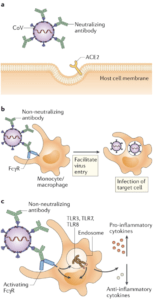
(a)In antibody-mediated viral neutralization, neutralizing antibodies binding to the receptor-binding domain (RBD) of the viral spike protein, as well as other domains, prevent virus from docking onto its entry receptor, ACE2. (b) In antibody-dependent enhancement of infection, low quality, low quantity, non-neutralizing antibodies bind to virus particles through the Fab domains. Fc receptors (FcRs) expressed on monocytes or macrophages bind to Fc domains of antibodies and facilitate viral entry and infection. (c) In antibody-mediated immune enhancement, low quality, low quantity, non-neutralizing antibodies bind to virus particles. Upon engagement by the Fc domains on antibodies, activating FcRs with ITAMs initiate signalling to upregulate pro-inflammatory cytokines and downregulate anti-inflammatory cytokines. Immune complexes and viral RNA in the endosomes can signal through Toll-like receptor 3 (TLR3), TLR7 and/or TLR8 to activate host cells, resulting in immunopathology. (Source: Iwasaki and Yang. Nat. Rev. Immunology 2020)
Which proteins do IgM and IgG antibodies recognise on the SARS-CoV-2 virus? Can these antibodies provide protection or facilitate inflammation and disease progression? The simple answer is that we don’t yet know, but a thoughtful commentary in Nature Reviews Immunology asked about the “potential danger of suboptimal antibody responses in COVID-19”. IgM is the first antibody to emerge rapidly after any infection, including viral infections, but IgM may initially also promote early inflammation through activation of the complement pathway. Initiation of inflammatory pathways is undoubtedly good to kick-start the immune response – but possibly catastrophic in some people who progress to COVID-19. Neutralizing IgG antibodies are good candidates for providing protective immunity, but also there is a phenomenon known as antibody-dependent enhancement (ADE). ADE is where pre-existing SARS-CoV-specific antibodies could promote viral entry into FcR-expressing cells, independently of ACE2 expression (the receptor for SARS-CoV-2). Fc receptors (FcRs) are expressed on a wide variety of immune cells, including those which are involved in antigen presentation and antibody production: monocytes, macrophages and B cells. Antibody concentrations appear to be crucial in determining their role and protective versus pathogenic antibodies need to be considered in approaches to vaccine design and immunization delivery.
Journal Article: Iwasaki and Yang. The potential danger of suboptimal antibody responses in COVID-19. Nature Reviews Immunology
Article by Clive Gray










